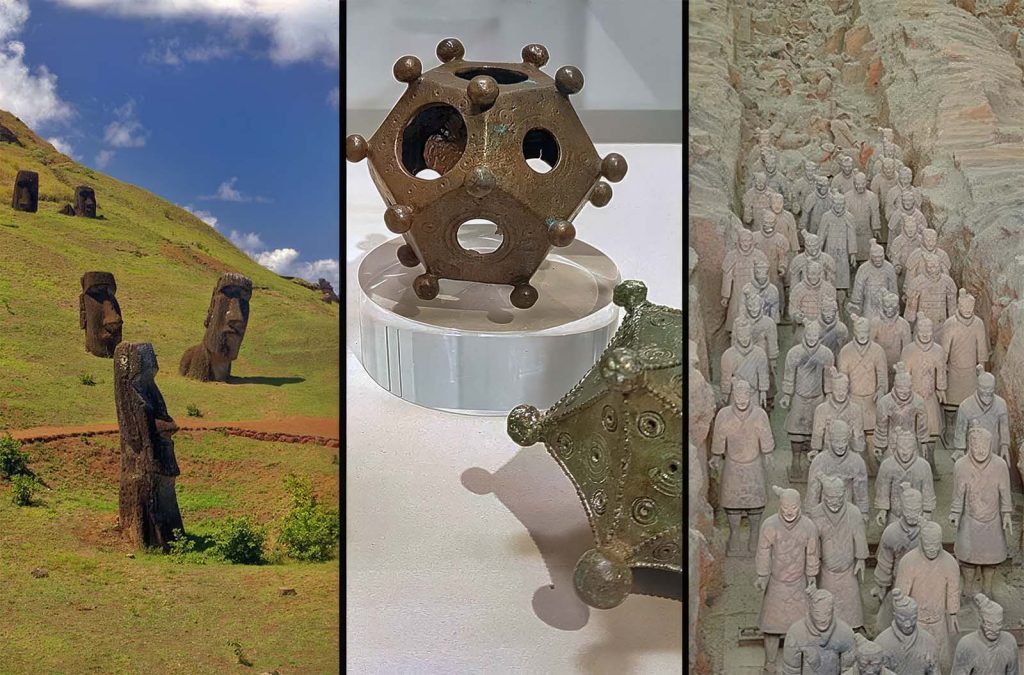Beneath the layers of ancient soil and forgotten ruins lie relics that have captivated and mystified historians for centuries.
From the colossal stone statues of Easter Island to the intricate lines carved into the Peruvian desert, these rare archaeological finds offer profound insights into past civilizations.
Each artifact, meticulously unearthed, reveals stories of human ingenuity, cultural rituals, and the relentless quest for knowledge.
These treasures not only bridge gaps in our understanding of history but also inspire awe with their enigmatic beauty and historical significance.
1. Rosetta Stone

The Rosetta Stone on display in the British Museum, London
The Rosetta Stone is a granodiorite stele that bears a decree from 196 BC, issued during Egypt’s Ptolemaic dynasty under the reign of King Ptolemy V Epiphanes.
The inscription is presented in three distinct scripts: Ancient Egyptian hieroglyphs at the top, Demotic script in the middle, and Ancient Greek at the bottom.
While the decree itself contains only minor variations between the three versions, the stone played a crucial role in unlocking the mysteries of Egyptian hieroglyphs.
Discovered in July 1799 by French officer Pierre-François Bouchard during Napoleon’s Egyptian campaign, it became the first bilingual text from Ancient Egypt recovered in modern history, sparking widespread excitement due to its potential for deciphering the once-indecipherable hieroglyphic script.
2. Dead Sea Scrolls

One of the 981 texts of the Dead Sea Scrolls.
The Dead Sea Scrolls are a collection of ancient Jewish manuscripts that date back to the Second Temple period.
Discovered between 1946 and 1956 in the Qumran Caves near Ein Feshkha, along the northern shore of the Dead Sea in the West Bank, these scrolls offer a glimpse into the religious and cultural practices of that time.
Spanning from the 3rd century BCE to the 1st century CE, they include some of the earliest known versions of biblical texts, as well as non-biblical and deuterocanonical writings from the late Second Temple era.
The majority of the approximately 15,000 scrolls and fragments are now preserved at the Shrine of the Book, part of the Israel Museum in Jerusalem.
3. Pompeii

The Garden of the Fugitives: plaster casts of victims still in situ; many casts are in the Archaeological Museum of Naples.
Pompeii was an ancient city located in what is now the municipality of Pompei, near Naples in Italy’s Campania region.
Along with neighboring towns like Herculaneum and Stabiae, Pompeii was buried beneath 4 to 6 meters (13 to 20 feet) of volcanic ash and pumice following the catastrophic eruption of Mount Vesuvius in 79 AD.
Largely preserved under the ash, Pompeii offers a unique snapshot of Roman life, frozen at the moment it was buried, as well as insight into ancient urban planning. It was a wealthy town of 10,000 to 20,000 residents at the time it was destroyed.
The ash also encased organic materials, including wooden objects and human bodies. As these decayed, they left behind cavities that allowed archaeologists to create detailed plaster casts of the city’s residents in their final moments.
4. Cave of Altamira.

Magdalenian polychrome bison.
The Cave of Altamira, located near the historic town of Santillana del Mar in Cantabria, Spain, is famous for its prehistoric art.
This cave complex contains charcoal drawings and vibrant polychrome paintings that depict local fauna and human handprints, offering a glimpse into life during the Upper Paleolithic period, approximately 36,000 years ago.
Discovered in 1868 by Modesto Cubillas, the site gained wider recognition through the studies of Marcelino Sanz de Sautuola, who helped bring attention to the significance of these ancient artworks.
5. Tomb of Tutankhamun

Tutankhamun’s tomb was provided with vast quantities of wealth, such as the mask of Tutankhamun.
The tomb of Tutankhamun, located in the Valley of the Kings, is the final resting place of the pharaoh who ruled from approximately 1332 to 1323 BC during Egypt’s Eighteenth Dynasty.
The tomb features four chambers, along with an entrance staircase and corridor. Unlike other royal tombs of its era, it is relatively modest in size and decoration, likely originally intended for a non-royal individual and later adapted for Tutankhamun following his early death.
Despite its limited space, the tomb housed an extensive array of funerary items and personal belongings, including coffins, furniture, clothing, and jewelry, all of which were packed tightly.
Discovered in 1922 by Howard Carter and his team , Tutankhamun’s tomb captured widespread attention due to the well-preserved nature of its contents, making it one of the most renowned discoveries in Egyptology.
6. Knossos

Reconstructed North Entrance in Knossos.
Knossos is a significant Bronze Age archaeological site situated on the island of Crete. It was a major hub of the Minoan civilization and is famously linked to the Greek myth of Theseus and the Minotaur.
Located just outside Heraklion, Knossos remains a prominent tourist attraction and is often regarded as the oldest city in Europe.
The site is best known for the grand Palace of Minos, which, like other Minoan palaces, functioned primarily as a religious and administrative center rather than a royal residence.
7. Antikythera mechanism

The Antikythera mechanism (fragment A – front and rear); visible is the largest gear in the mechanism, about 13 cm (5 in) in diameter.
The Antikythera mechanism is an Ancient Greek hand-powered orrery, considered the oldest known example of an analog computer.
It was designed to predict astronomical positions and eclipses years in advance and could also track the four-year cycle of athletic games akin to the ancient Olympic Games.
This rare artifact was discovered among the wreckage of a shipwreck off the coast of the Greek island of Antikythera in 1901.
8. The Pilate Stone

Pontius Pilate inscription; the original stone, now located in the Israel Museum, Jerusalem.
The Pilate Stone is a fragmented limestone block bearing a partially preserved inscription referencing Pontius Pilate, who served as the prefect of the Roman province of Judea from AD 26 to 36.
Discovered at Caesarea Maritima in 1961, this artifact holds considerable historical value as it is one of the few genuine 1st-century Roman inscriptions mentioning “[Pon]tius Pilatus.”
Its dating aligns with Pilate’s lifetime and is consistent with historical accounts of his career.
Consequently, the Pilate Stone represents the earliest and only contemporary record of Pilate, who is otherwise known primarily from the New Testament and apocryphal writings.
9. Olduvai Gorge

Close-up of monolith made of red sediments.
The Olduvai Gorge or Oldupai Gorge in Tanzania is one of the most important paleoanthropological localities in the world; the many sites exposed by the gorge have proven invaluable in furthering understanding of early human evolution.
The locality is significant in showing the increasing developmental and social complexities in the earliest Hominina, largely revealed in the production and use of stone tools.
Prior to tools, evidence of scavenging and hunting can be noted—highlighted by the presence of gnaw marks that predate cut marks—and of the ratio of meat versus plant material in the early hominin diet.
The collecting of tools and animal remains in a centralized area is evidence of developing social interaction and communal activity.
10. Hagar Qim

The facade of the main temple of Ħaġar Qim, seen prior to the 2009 construction of a protective shelter.
Hagar Qim is a megalithic temple complex located on the Mediterranean island of Malta, dating back to the Ġgantija phase (3600–3200 BC).
The Megalithic Temples of Malta are among the oldest religious sites in the world, and the World Heritage Sites committee has described them as “unique architectural masterpieces.”
11. Terracotta Army

View of the Terracotta Army.
The Terracotta Army is a collection of terracotta sculptures depicting the armies of Qin Shi Huang, the first emperor of China.
It is a form of funerary art buried with the emperor in 210–209 BCE with the purpose of protecting him in his afterlife.
The figures, dating from approximately the late 200s BCE, were discovered in 1974 by local farmers in Lintong County, outside Xi’an, Shaanxi, China.
Estimates from 2007 were that the three pits containing the Terracotta Army hold more than 8,000 soldiers, 130 chariots with 520 horses, and 150 cavalry horses.
12. Tomb of Philip II of Macedon

Weapons, armor, gold, and silver artifacts lay beside precious ossuaries containing cremated bones in these unique tombs close to the necropolis of Aegae, the ancient capital of Macedon.
13. The Staffordshire Hoard

A selection of highlight pieces from the Staffordshire Hoard (top) and a gold sword hilt fitting with cloisonné garnet inlay, uncleaned by conservators, still showing traces of soil.
The Staffordshire Hoard is the largest collection of Anglo-Saxon gold and silver metalwork ever discovered.
It includes nearly 4,600 items and metal fragments, totaling 5.1 kg (11 lb) of gold, 1.4 kg (3 lb) of silver, and approximately 3,500 pieces of garnet cloisonné jewelry.
Historian Cat Jarman has described it as “possibly the finest collection of early medieval artifacts ever discovered.”
Believed to have been buried between 650 and 675 CE, the hoard contains artifacts likely produced during the 6th and 7th centuries.
It was unearthed in 2009 in a field near Hammerwich, close to Lichfield, in Staffordshire, England.
14. Baghdad batteries

Baghdad batteries.
The Baghdad Battery refers to a set of three artifacts—a ceramic pot, a copper tube, and an iron rod—discovered together in 1936 near Khujut Rabu, Iraq, close to the ancient city of Ctesiphon, the capital of the Parthian and Sasanian empires.
Dating back to one of these periods, the exact origin and purpose of the artifact remain a mystery.
Wilhelm König, the director of the National Museum of Iraq at the time, proposed that it may have functioned as a galvanic cell, possibly used for electroplating or electrotherapy.
Another theory suggests it may have served as a container for sacred scrolls.
Roman dodecahedra

Two dodecahedra and an icosahedron on display in the Rheinisches Landesmuseum Bonn, Germany.
A Roman dodecahedron, or Gallo-Roman dodecahedron, is a small hollow object made of cast copper alloy, shaped into a regular dodecahedron with twelve flat pentagonal faces.
Each face features a circular hole of varying diameter that leads to the hollow interior, and each corner is adorned with a protruding knob. These artifacts date from the 2nd to 4th centuries AD, though their exact purpose remains unknown.
They show little to no signs of wear and lack inscribed numbers or letters. Some were found in coin hoards, suggesting they were either considered valuable or possibly used to measure the diameter of coins.
Other theories propose they were religious artifacts or used for fortune-telling.
16. Stone spheres of Costa Rica

Stone spheres of the Diquís at the Finca 6 archaeological site.
The stone spheres of Costa Rica are a collection of more than 300 petrospheres found in the Diquís Delta and on Isla del Caño.
Locally referred to as “bolas de piedra” (stone balls), they are often attributed to the extinct Diquís culture and are sometimes called the Diquís Spheres.
These sculptures are among the most notable stone works from the Isthmo-Colombian region.
It is believed they were aligned along the approach to the homes of chiefs, though their precise purpose and significance remain unclear.
17. Rapa Nui Statues

Outer slope of the Rano Raraku volcano, the quarry of the Moais with many uncompleted statues.
Easter Island, a special territory of Chile, is located in the southeastern Pacific Ocean at the farthest southeastern point of the Polynesian Triangle in Oceania.
The island is renowned for its nearly 1,000 monumental statues known as moai, created by the early Rapa Nui people.
While almost half remain at Rano Raraku, the main quarry, many were moved and placed on stone platforms called ahu along the island’s coast.
Most moai are characterized by disproportionately large heads, which make up about three-eighths of the total statue, and notably, none of them have legs.
18. Piri Reis Map

Surviving fragment of the Piri Reis map.
The Piri Reis map, compiled in 1513 by the Ottoman admiral and cartographer Piri Reis, is a world map with only a surviving fragment now housed in the Topkapı Palace in Istanbul.
Rediscovered in 1929, the map drew international attention for its inclusion of a partial copy of a now-lost map by Christopher Columbus.
The map’s depiction of South America is detailed for its time. Scholars suggest that the peculiar arrangement of the Caribbean may have been influenced by an early map that portrayed Cuba as part of the Asian mainland and Hispaniola according to Marco Polo’s description of Japan.
The southern section of the map is generally interpreted as an early version of Terra Australis.
Nazca Lines

Aerial photograph of one of the Nazca lines, taken in July 2015, that shows the design known as “The monkey”.
The Nazca Lines are a collection of geoglyphs etched into the desert floor of southern Peru’s Nazca Desert.
Created between 500 BC and 500 AD, these designs were made by removing surface pebbles to reveal the contrasting, lighter-colored earth beneath.
While many lines run straight across the terrain, others form intricate depictions of animals and plants. Spanning a total length of over 1,300 kilometers (800 miles), the geoglyphs cover an area of roughly 50 square kilometers (19 square miles), with the lines themselves typically measuring 10 to 15 centimeters (4–6 inches) in depth.
20. Voynich Manuscript

A floral illustration on page 32.
The Voynich manuscript is an illustrated codex, written in an unknown script that has yet to be deciphered. Carbon dating of the vellum places its creation between 1404 and 1438.
Its origins, authorship, and purpose remain a subject of debate, with theories suggesting it could represent a natural or constructed language, a coded message, or some form of cryptography.
Other possibilities include a hoax, a reference work, or a piece of speculative fiction, such as science fantasy or mythopoeia, awaiting the context and translation needed to clarify its meaning.
The manuscript is named after Wilfrid Voynich, the Polish book dealer who acquired it in 1912.
21. Göbekli Tepe

The site is renowned for its large, circular structures featuring massive stone pillars, which are among the oldest known megaliths in the world.
These pillars are adorned with intricate carvings, including anthropomorphic figures, depictions of clothing, and reliefs of wild animals.
These artistic details offer archaeologists valuable insights into prehistoric religion and the symbolic iconography of that era.
22. Sacsayhuamán

Situated at an elevation of 3,701 meters (12,142 feet), this impressive complex was constructed in the 15th century, primarily under the reign of Sapa Inca Pachacuti and his successors.
The site is renowned for its massive dry stone walls, composed of large boulders intricately cut and fitted together without the use of mortar, showcasing the exceptional engineering skills of the Inca civilization.
23. Sea of Galilee Boat

The ‘Ancient Galilee Boat’ housed in the Yigal Allon Museum in Kibbutz Ginosar.
The Ancient Galilee Boat, also referred to as the Jesus Boat, is a fishing vessel from the 1st century AD, discovered in 1986 on the northwest shore of the Sea of Galilee in Israel.
The boat, measuring 27 feet (8.2 meters) in length, 7.5 feet (2.3 meters) in width, and with a preserved height of 4.3 feet (1.3 meters), was revealed during a drought when the lake’s water levels receded.
Despite its historical dating, there is no direct evidence linking the boat to Jesus or his disciples.
24. Grauballe Man

On display at Moesgaard Museum.
The Grauballe Man is a bog body discovered in 1952 in a peat bog near the village of Grauballe in Jutland, Denmark.
This well-preserved corpse dates back to the late 3rd century BC, during the early Germanic Iron Age.
Evidence suggests that he met his death from a slit throat. After his death, his body was placed in the bog, where natural preservation conditions allowed it to remain intact for over two millennia.
(Photo credit: RHP).



